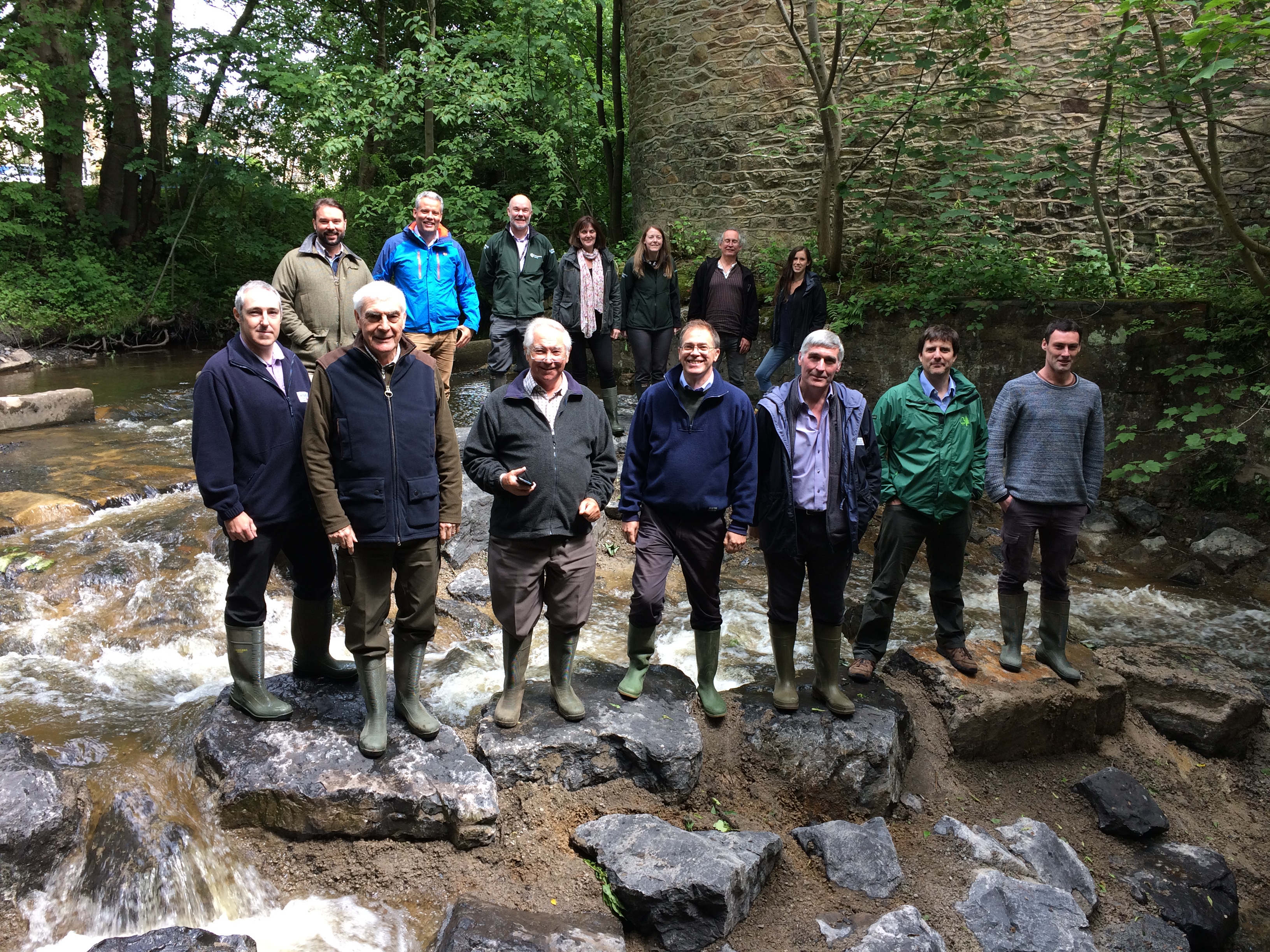Ribble Life
- Catchment HostRibble Catchment Conservation Trust Ltd. (Trading as Ribble Rivers Trust)
- River Basin DistrictNorth West
- Management CatchmentRibble
- Management Catchment ID3070
Catchment partnership vision
Through collaboration we will create a thriving land and water environment within the Ribble Catchment that will bring economic, health and social benefits for all. The agreed goals to achieve the vision are to:
- improve the rivers, estuary and other water bodies in the Ribble Catchment, supporting a vibrant and resilient economy and creating a great place to live
- deliver greater impact through collaborative projects that result in improvements to our water environment with multiple benefits
- work collaboratively to combat the causes of climate change and ensure that the natural capital (benefits and assets) of the catchment are valued and protected
- enhance the amenity value of the water environment within the Ribble Catchment.The partnership goals also specifically support the achievement of the government’s 25 Year Plan by delivering activities that will contribute to positive change as measured by the environment plan outcome indicators.

Ronny Marsden
Related websites
Find out more about the activities and ambitions of this catchment partnership and how you can get involved to help improve the water environment in the catchment.
Catchment challenges
Current challenges identified by partnership

Physical modifications
Much of our catchment has legacy infrastructure from the industrial revolution - weirs, sluices, mill works

Pollution from agriculture and rural areas
Our catchment is predominantly upland livestock farming, with dairy farms throughout the catchment

Pollution from waste water
With high rainfall, the Ribble Catchment is affected by high flow events resulting in combined sewer overflows
Wider water environment challenges identified by partnership
Support Nature Recovery Network and Local Nature Recovery Strategy
Nature recovery and improving habitat connectivity are key to many of our projects, e.g. riparian woodland creation, weir removal, fish pass projects
Connecting communities with nature
Experience and evidence show that education and connecting people with nature support long-term environmental improvements and project success
Protect and restore healthy soils and nutrient balance
Managing the land through which water flows is hugely important to healthy catchments and forms part of wider education and improvement work
Improved bathing waters (including inland)
Improving bathing waters requires wider improvements that support cleaner water, this aim will encompass a range of projects with multiple benefits
Build environmental resilience and adaptation to climate change
Climate change is a global challenge, healthy catchments create resilience and provide multiple benefits for people, nature and the planet
Removing plastics/litter from the water environment
Straightforward actions like this can engage and involve communities in practical action that makes a difference to their local river environment
Future challenges predicted by partnership

Physical modifications
Species migration is severely limited by legacy infrastructure from the industrial revolution (weirs, channel straightening, sluices, mill works)

Pollution from agriculture and rural areas
Our catchment has a huge variety of farms (dairy, livestock, livestock and arable) with farmers balancing productivity with sustainability

Pollution from waste water
With high rainfall coupled with a growing population and an ageing infrastructure, the catchment suffers significant combined sewer overflows
Future challenges predicted by Environment Agency
Future challenges in 2050
- Invasive Non-native Species
- Physical Modifications
- Pollution from Agriculture and Rural Areas
Emerging challenges
- Pollution from Agriculture and Rural Areas
- Pollution from waste water
- Physical Modifications
Partnership success highlights 2016 to 2021
In March 2022 we finished Ribble Life Together, which started in 2017 and included:
- 14 weir removal or fish pass creation projects
- the creation of 30 new woodlands and 15 wetland projects
- education and engagement activities such as bat walks, sketch workshops, volunteering, river walks, short films and a podcast.Two of our key programmes being delivered are:1) Ribble Life for Water, a £1.5 million Water Environment Grant partnership programme involving several partners, consisting of large infrastructure projects targeting areas of the catchment that are most in need of improvement and restoration. Projects include:
- peat restoration
- weir removal
- a bypass channel fish passage project
- river naturalisation and the removal of 400 metres of concrete lining a river channel
- a fish passage feasibility study at arguably the biggest barrier to fish movement in the whole catchment.2) Health and Environmental Action Lancashire (HEAL). Prioritising disadvantaged communities and those with long-term health conditions, HEAL will connect people with nature across the Ribble, Lune and Wyre Catchments, protect species, create and restore habitats. This programme includes:
- heathland, wildflower meadow and woodland management
- river enhancement including wetland creation
- community asset improvement
- active volunteering and engagement activities which help improve both physical and mental health and wellbeing
- safeguarding and creating jobs across the partnership.We are developing new partnerships and improving how environmental charities, public bodies and local businesses work together to protect and improve our water resources and the wider environment.

Partnership development plans
The partnership is strong with high levels of engagement with our meetings, consultations, and wider activities. We will build on the success of the last few years by developing and delivering more collaborative projects. We have developed GIS, data and evidence-based tools to support more effective identification and prioritisation of projects, helping us focus our work. In future we will use these assets to grow our network and continue our work and positive impact throughout the catchment. We would like to become more inclusive – reflecting the catchment we serve and engaging more widely with communities. We will engage with Defra’s new Environmental Land Management Schemes (ELMS), and ensure strong local representation of the water environment through engagement with Local Nature Recovery Strategies (LNRS). We will build stronger working relationships with local stakeholders and providing local expertise to support ongoing investment and enhancement of our catchment area.
Partnership priority actions and measures for 2022 to 2027
Confident
Enhancement/no deterioration measures in 2020-2025 Water Industry National Environment Programme
- Reason for measure
- Control or manage point source discharges
- Delivery mechanism
- Confirmed water industry national environment programme 2020-2025
- Location
- Ribble
Confident
'Ribble Tributrees' – woodland creation programme
- Reason for measure
- Control or manage urban diffuse pollution
- Delivery mechanism
- WEIF Water Environment Improvement Fund
- Location
- Ribble
Confident
Loud catchment natural flood management programme
- Reason for measure
- Control or manage rural diffuse pollution
- Delivery mechanism
- Confirmed water industry national environment programme 2020-2025
- Location
- Loud - Lower Chipping Brook
Confident
Deeper Connections: restoring Long Preston Deeps
- Reason for measure
- Control or manage regulated flows
- Delivery mechanism
- Green Recovery Challenge Fund/Challenge Fund
- Location
- Ribble (Stainforth to Long Preston Beck)
Less certain
Preston Flood Resilience mitigation and enhancement programme
- Reason for measure
- Mitigate the impacts on ecology from physical modifications in modified waters
- Delivery mechanism
- EA Flood/coastal risk management programme
- Barriers to delivery
- Delays in woodland creation process due to implementation of new guidance
- Location
- Big Ribble
Less certain
Invasive Non-native Species monitoring and management
- Reason for measure
- Control or manage invasive non-native species
- Delivery mechanism
- Voluntary initiatives
- Barriers to delivery
- Funding to support the co-ordination of work
- Location
- Ribble
Less certain
Darwen, Trawden and Whalley NFM
- Reason for measure
- Control or manage regulated flows
- Delivery mechanism
- EA Flood/coastal risk management programme
- Barriers to delivery
- Awaiting funding decision
- Location
- Calder Darwen Colne Water
Less certain
Evidence & Engagement for Planning
- Reason for measure
- Feasibility study to build commitment to deliver
- Delivery mechanism
- WEIF Water Environment Improvement Fund
- Barriers to delivery
- Confirmation of funding and detailed plan
- Location
- Darwen
Wider water environment
Community project development
- Reason for measure
- Connecting communities with nature
- Delivery mechanism
- Other philanthropic/charitable/trust funds
- Location
- Ribble
Wider water environment
Ribble Bathing Water Project
- Reason for measure
- Improved bathing waters (including inland)
- Delivery mechanism
- Other philanthropic/charitable/trust funds
- Location
- Ribble Middle - Settle to Calder
Wider water environment
River Clean Up Programme
- Reason for measure
- Removing plastics/litter from the water environment
- Delivery mechanism
- Voluntary initiatives
- Location
- Ribble
Catchment Partnership contributors
Partners involved in the creation of this page and the actions of the partnership:
- Forest of Bowland AONB
- Environment Agency
- Blackburn with Darwen Borough Council
- Natural England and Catchment Sensitive Farming
- Lancaster University
- Yorkshire Dales National Park Authority
- Woodland Trust
- Ribble Fisheries Consultative Association (RFCA)
- Lancashire County Council
- National Farmers Union
- Marine Management Organisation
- RSPB
- Wildlife Trust for Lancashire, Manchester and North Merseyside
- United Utilities
- Forestry Commission
- Ribble Rivers Trust (Host)
- LOVEmyBEACH
- Yorkshire Dales Millennium Trust